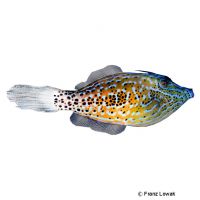Scrawled Filefish (Aluterus scriptus)
| Scrawled Filefish Aluterus scriptus | |
|---|---|
| Name | Scrawled Filefish |
| Name Lat. | Aluterus scriptus |
| Family | Filefishes |
| Family lat. | Monacanthidae |
| Order | Puffers & Filefishes |
| Order lat. | Tetraodontiformes |
| Origin | Atlantic, Indo-Pacific |
| Habitat | Lagoons, seaward reefs |
| Diet | Omnivore |
| pH | 8.1-8.4 |
| Hardness | 8-10 °KH |
| Behavior | Peaceful |
| Keeping | Individual |
| Reef Compatible | With caution |
| Care Level | Experts only |
| Life Span | N/A |
| Protection | No |
| Metric Units | |
| Size | 55 cm |
| Temperature | 22-28 °C |
| Salinity | 33-36 ‰ |
| Aquarium | ~ 2.000 l |
| US Units | |
| Size | 22" |
| Temperature | 72-82 °F |
| Salinity | 1.020-1.025 sg |
| Aquarium | ~ 500 gal |
Distribution and habitat
Aluterus scriptus are distributed worldwide in all tropical seas of the Atlantic and Indian Oceans and the Pacific Ocean (circumtropical). They live there in lagoons as well as on steep slopes of outer reefs, occasionally also under floating water plants in the open sea.
Maintenance
They require a calm, well-structured aquarium with rock or stone structures with living stones, which offer sufficient hiding, resting and retreat possibilities (overhangs) as well as much swimming space with fine-grained sand surfaces. Only lime-rich, heavy metal-free sands, gravels, stones or sea sand may be used.
Filters, skimmers and heaters are necessary to ensure water quality, as well as pumps to simulate tides, swells and bottom currents. Lighting must be appropriate for the species' day-night rhythm
| Salinity: 33-36 ‰ | pH value: 8.1-8.4 |
| Carbonate hardness: 8-10 °KH | Nitrate content: 2-8 mg/l |
| phosphate content: 0.01-0.1 mg/l | nitrite content: 0.0-0.05 mg/l |
For salinity, an average value should be aimed for, which may only vary slightly by +/- 0.5 ‰. Ammonia and ammonium must not be measurable. Special attention must be paid to constantly good water quality.
Diet
In nature, they feed on gorgonians, anemones, sea squirts and other tunicates, as well as algae and seaweed. The food supply should consist of live and frozen foods such as mysis, krill and artemia, as well as glass lizard, fish, shrimp and squid meat, and high-quality flake and granulated foods are also accepted. In addition, they require plant food, such as caulerpa and algae (e.g., norialgae). Lettuce (organic lettuce), spinach and dandelion leaves can also be offered
It is recommended to feed small portions several times a day. Regular and varied feeding promotes health and increases resistance.
Behaviour and compatibility
Because of intraspecific incompatibility, single keeping is recommended. They can be socialized with other calm fish.
Sex dimorphism
No external distinguishing characteristics are known. Adults are olive-brown to gray colored with small black spots. Juvenile animals are rather yellowish-brown colored with dark spots.
Reproduction and breeding
There are no known reports of successful breeding in the aquarium.
Important
They can change color and pattern very quickly depending on the environment. When socialized with other fish they often suffer from food competition as they are slow eaters
Due to their natural feeding habits, there is a risk that they will also eat corals and invertebrates (e.g. tubeworms).
If different species are kept together, care should be taken to ensure that the fish match each other in terms of water quality and temperature requirements, as well as their social behavior, and that the setup meets the needs of all species kept together. Newly introduced fish must be acclimated slowly to the water in the aquarium
Further literature can be found in your pet store.
References
Text: Werner Winter; Image: Franz Lowak
Source: KUITER, DEBELIUS (2007): Atlas der Meeresfische: Die Fische an den Küsten der Weltmeere, Kosmos Verlag; PATZNER & MOOSLEITNER (1999): Meerwasser Atlas Bd. 6, Mergus Verlag; ENGELMANN (2005): Zootierhaltung - Tiere in menschlicher Obhut: Fische, Verlag Harri Deutsch
- Gemäß § 21 Abs. 5 Tierschutzgesetz idgF
